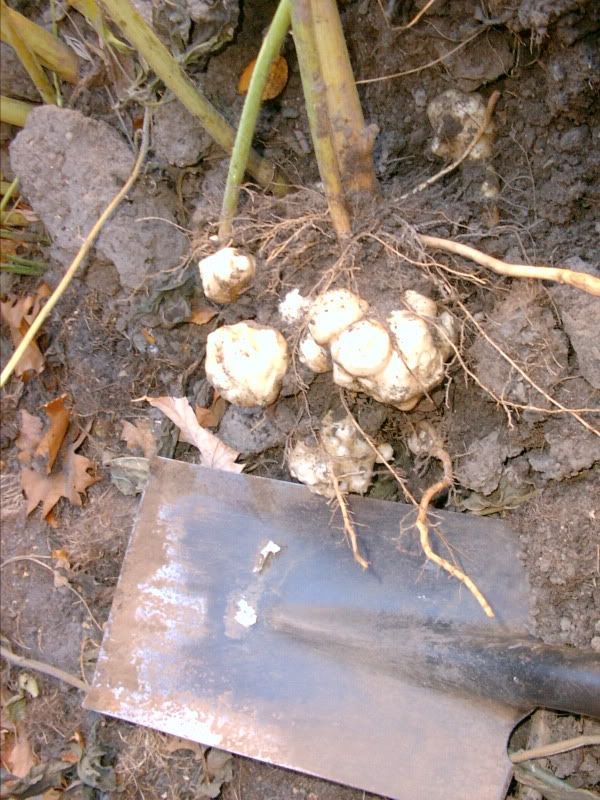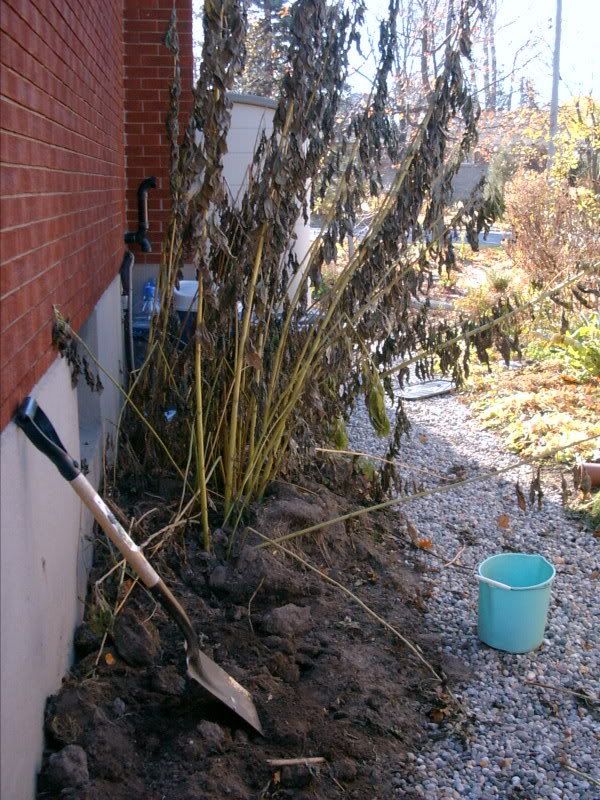Up came the parsnips, some turnips to the chagrin of my hubby, carrots and beets. Most of these I leave in the ground under a coldframe and mulch. Carrots, at any rate, overwinter here without any significant protection, just a pile of leaves. The disadvantage is that you can't dig them up when there is three feet of frozen dirt.
I also yanked my celariac (a subject for another post) and my Jerusalum Artichokes:

Jerusalum Artichoke tubers with a shovel for scale
I had so many that I was guilty of leaving bags of them on some of my neighbour's door knobs. Now, I know that some of these people have tasted JAs before, but for some they were mighty puzzled until I gave them a phone call to explain.
For those of you that don't know, in the summer, this relative of the sunflower produces Jack-in-the-Beanstalk sized stems topped with tiny weeny yellow flowers at the very end of the season. Their energy expenditure (besides going into producing these massive stalks) goes into producing knobbly, crispy, white, and tasty tubers.

Jerusalum Artichoke blackened by frost.
The first time I tasted them, I 'liked' them but was a bit surprised as I had not had anything quite like them and I will not try to describe them to you either. They can be used in much the same way as potatoes, but unlike this starchy tuber, the crisp JA can aslo be used raw in salads or for dipping.
But the best thing about this plant is that it is hard to kill, easy to grow, relatively pest free, nutritious and perennial. Oh and it contains a starch called inulin is save for diabetics (though some say it causes wind). Why doesn't anyone grow it?
Did I mention that it was hard to kill? Any tuber left in the ground will sprout and it is hard to get all of them. Some people curse this plant if they discover it left to romp unattended by previous owners especially as it is a descent screen but not a particularly decorative plant:

Jerusalum Artichoke - aka the Jack in the Beanstalk plant (credit to my neighbour for the nickname. She says she stares at it while washing dishes)
It does not store as well as other tubers, but can be kept a while (a month, two, accounts vary) in a moist, cool environment. I usually roast and puree mine then freeze to add to stews etc... Besides, depending on the year, it is diggable from September to November and then again from March to May so those are just JA seasons.
A pest for every plant
Okay, so it really is a great plant. Only I was a bit dissapointed to note that I had some root maggots. I would have looked for them but I hadn't expected to see them in this noted pest free plant. At any rate, they are easy to remove. Let's hope they are not too much of a pest next year.
Plant it and they will come...
Links
JA growing page
Mapple Farms - Canadian Distributor

7 comments:
I just planted some JA in my new garden over the weekend. I know I'll probably regret doing it, but I like the tubers and always like growing something that gives you more than you can eat and enough to share.
What we planted was a few tubers of what we grew on our roof this year, and we ate most of the rest. Normally they don't bother us, but this time -- talk about wind! Kept us up half the night. I wonder why this sometimes happens.
I've never heard of harvesting in March to May. Do you just dig tubers that have been in the ground all winter, or are these newly formed tubers like new potatoes?
Except maybe a little tofu for stirfrys, I don't usually 'deep' fry anything. I've read you can make JA chips by slicing 1/8" (3mm) thick and deep frying in oil. Have you ever tried this?
I guess inulin is indigestable by the intestine but broken down by bacteria in the colon. This has many health benefits that are complex but include sugar regulation etc... Anyhow, the bacteria produces 'gases' as a by-product. Inulin is also found in beans which are infamous for producing gas and many other storage tubers including chicory and dandelion.
Though I haven't read the specifics, some people become accostumed to it?? Anyhow, I don't get much gas from it. Last night, I had a JA based soup and did not have more 'wind' than usual which was not much. So maybe it depends on growing conditions how much inulin is in the tuber? Not sure.
Yup. I just harvest them out of the ground before they start sprouting in ernest again in March through May. The season depends on the weather. They are the overwintered tubers from last year.
I have never made JA chips. I'm sure my kids would love it.
I bought some purple ones (purple skin, light flesh) at the farmer's market at Lansdowne Park this year... saved a few and planted them. Looking forward to seeing what comes up, and if the plants are any different from the standard variety.
Two of my favorite topics in your last two posts: JA and leaves. Mulch 'em, mould 'em, spread 'em under bushes, mound 'em over tender plants, leaves are the gardener's best friend. And JA are magical plants. I just harvested 40 pounds of them, from about 10 plants! Thankfully, our house is well ventilated.
My JA never grew so tall that is before I did kill them (don't know how, btw). Congratulations for yours.
These look like interesting veggies with cool foliage. I've heard the name before, but I've never seen them. What a little sweetheart ambling down the path!
I was disappointed in the size of the flower the first year I grew JA's. I do love how tall they grow as they hide up all the ugly sheds in the neighbours yard!! I'm at a point now that I dig them and give them away too.
Post a Comment